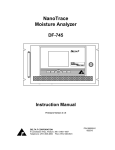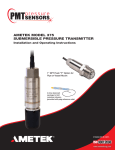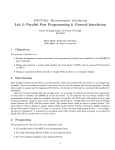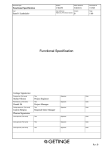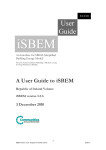Download HP T100 Specifications
Transcript
MODEL HPT 100 SERIES HIGH PURITY PRESSURE TRANSMITTER INSTRUCTIONS FOR INSTALLATION, OPERATION AND CALIBRATION U.S GAUGE DIVISON PMT PRODUCTS HPT 100 SERIES WARRANTY POLICY Ametek warrants these products for a period of three years from the date of shipment or date of registration if the card is submitted and that all products manufactured by the seller are free from defects of material and workmanship when used within the service, range, and purpose for which they were manufactured. Seller will, at its option, repair, replace, or refund the purchase price of parts found by Seller to be defective in material or workmanship provided that written notice of such defect requesting instructions for repair, replacement, or refund is received by Seller at the address below within the warranty period and provided that any instructions thereafter given by Seller are complied with. This warranty shall not apply (i) to the performance of any system of which Seller's products are a component part, (ii) to deterioration by corrosion or any cause of failure other than defect of material or workmanship, or (iii) to any of Seller's products or parts thereof which have been tampered with or altered or repaired by anyone except Seller or someone authorized by Seller, or subjected to misuse, neglect, abuse or improper. use or misapplication such as breakage by negligence, accident, vandalism, the elements, shock, vibration, or exposure to any other service, range, or environment of greater severity than that for which the products were designed. SELLER MAKES NO WARRANTY OF ANY KIND, EXPRESS OR IMPLIED. INCLUDING WITHOUT LIMITATION ANY WARRANTIES OF FITNESS OR OF MERCHANTABILITY WITH RESPECT TO ITS PRODUCTS, OR ANY PART THEREOF, OTHER THAN AS EXPRESSLY SET FORTH ABOVE. NOR SHALL SELLER HAVE INCURRED ANY OTHER OBLIGATIONS OR LIABILITIES OR BE LIABLE FOR ANY ANTICIPATED OR LOST PROFITS, INCIDENTAL DAMAGES, CONSEQUENTIAL DAMAGES, TIME CHARGES, OR ANY OTHER LOSSES INCURRED IN CONNECTION WITH THE PURCHASE, INSTALLATION, REPAIR, OR OPERATION OF ITS PRODUCTS (INCLUDING ANY PARTS REPAIRED OR REPLACED). This warranty does not extend to anyone other than the original Buyer from Seller and Seller’s agents. CONTENTS cover WARRANTY Seller’s Registration Card ii INTRODUCTION iii Safety Summary SECTION I- SPECIFICATIONS Model HPT 100 Series Transmitter Model Number System Description Specifications EMI / RFI Immunity- C.E. Classification Safety Approvals CE Declaration Of Conformity 1-1 1-2 1-2 1-4 1-5 1-9 SECTION II - INSTALLATION Mechanical Electrical Outdoor 2-1 2-2 2-6 SECTION III - OPERATION Principle Of Operation 3-1 SECTION IV - CALIBRATION Calibration Procedures Zero / Span Pot & Diagnostic Shunt Location Diagram 4-1 4-2 SECTION V - SERVICE AND PARTS Factory Service Circuit Board Replacement Spare Parts 5-1 5-2 5-3 i WARRANTY REGISTRATION REPORT DISTRIBUTOR: DATE: LOCATION: CUSTOMER: CONTACT NAME: ADDRESS: PHONE: The units listed below have been delivered and the warranty period has begun. A copy of the invoice is attached. SERIAL # DESCRIPTION GAS SERVICE ii FLOW RATE OP. PRESS _____________________________________________________INTRODUCTION The HPT 100 is a series of pressure transmitters specifically designed to meet the ultra-clean and ultra-high stability and reliability requirements of the semiconductor industry. Because most of the process gases to be measured by the HPT 100 are highly reactive and pose toxic threats to the facility personnel, the manufacturing tolerances and operating specifications are very strict. Many of these units will be permanently welded into the gas distribution system, so the design includes external access to the electronic circuitry by qualified repair personnel and zero and span pots for field calibration. All HPT 100 units are labeled with the C.E. mark certifying compliance with European standards for RFI/EMI immunity. HPT 100 units with the suffix ‘1’ in the model number are labeled with agency approval from Canadian Standards Association (CSA) and Laboratoire Central Des Industries Electriques (LCIE) for Intrinsically Safe and Non-Incendive Systems for operation in hazardous locations. HPT 100 units with the suffix ‘2’ in the model number are labeled with CSA approval for operation in Division 2 Locations. HPT 100 units with the electrical connection suffix “N” or “C” or “P” are rated NEMA 4X Enclosure by CSA and IP56 Enclosure by LCIE. Electrical Connection Suffix “N” or “C” is recommended for outdoor use. SAFETY SUMMARY This instrument is designed to prevent accidental shock to the operator when properly used. However, no design can ensure the safety of an instrument improperly installed or used negligently. Read this manual carefully and completely before operating the instrument. Failure to read this manual in its entirety could result in damage to the instrument or injury to the operator. Standard safety precautions must be used during installation and operation. Important messages located throughout this manual are as follows: WARNING - Denotes a hazardous procedure or condition which, if ignored, could result in injury or death to the operator. CAUTION - Denotes a hazardous procedure or condition which, if ignored, could result in damage or destruction to the instrument. IMPORTANT - Denotes a procedure or condition which is essential to the correct operation of the instrument. NOTE - Specifies supplementary and perhaps essential information in relation to a particular procedure or condition. iii SECTION I 100 SPECIFICATIONS - - - - - - AGENCY APPROVAL 1 = Intrinsic Safety/ Non-Incendive 2 = Division 2 3 = No Rating ELECTRICAL CONNECTION B = Bendix Type P = Pigtail C = Outdoor-1/2" Conduit Adapter N = Outdoor-10 ft. Pigtail OUTPUT 1 = 4 -20 mA. 2 = 0-5 Vdc PROCESS SIZE 4 = 1/4" 6 = 3/8" 8 = 1/2" PROCESS CONNECTION TYPE SM =Face Seal Swivel Male SF = Face Seal Swivel Female FM = Face Seal Integral Fixed Male BW = Butt Weld Tube Stub TS = Swept Path Tee (Pressure Cavilty Type Option "S" only) PRESSURE RANGE 0100 = 100 Psi 0250 = 250 Psi 1000 = 1000 Psi 2000 = 2000 Psi 3000 = 3000 Psi ZERO REFERENCE V = -14.7 Psig G = 0 Psig/ 0 Bar A = Absolute* PRESSURE CAVITY TYPE F = Flow Through S = Single-ended * Absolute Pressure Ranges provided as a vacuum gauge reference i.e 0-250 Psia provided as -14.7 Psig to 235.3 Psig pg. 1-1 DESCRIPTION: The HPT 100F is a flow-through style transmitter while the HPT 100S is a single-ended or deadleg style. Each style is available with a variety of tube stub and face seal connections. Electrical connection is via either a Bendix® compatible 4 pin connector or a flying lead pigtail. The small size and light weight of the HPT 100 eliminates the need for bulky mounting hardware and mechanical supports. FUNCTIONAL SPECIFICATIONS: SERVICE: Liquid, gas or vapor AVAILABLE RANGES: vac to 100 psig, vac to 250 psig, vac to 1000 psig, vac to 2000 psig, vac to 3000 psig. Alternate ranges, including Bar and lower ranges, are available. OUTPUT: 4-20 mA, 2 wire, current limited with reverse polarity protection or 0-5 Vdc (Calibrated 0.1- 5.1 Vdc) POWER SUPPLY: 12 to 30 Vdc LOOP RESISTANCE (4 - 20 mA.): 900 ohms at 30 Vdc; 0 ohms at 12 Vdc OUTPUT LOAD (0 - 5 Vdc): > 50K ohms SPAN/ZERO ADJUSTMENT: +/- 5% of span minimum TEMPERATURE LIMITS: COMPENSATED: OPERATING: STORAGE: 0OC to 50OC -25OC to 85OC -40OC to 85OC HUMIDITY: 0-95% RH (pigtail cable) * 0-95% RH (Bendix® type >=500 psig) 0-80% RH (Bendix® type <500 psig) OVERRANGE: BURST PRESSURE: 150% of Full Scale 400% of Full Scale HAZARDOUS LOCATIONS: INTRINSICALLY SAFE: Class I, Division 1, Groups A, B, C & D, NEMA 4X (IP56) Approved Barrier Required DIVISION 2: Class I, Division 2, Groups A, B, C & D, NEMA 4X Protective Enclosure or Conduit Connection Required Note: NEMA 4X/IP56 applies to pigtail terminations version only *(vent through cable to dry environment) DIELECTRIC ISOLATION: 100V DC pg. 1-2 PERFORMANCE SPECIFICATIONS: ACCURACY: ± 0.25% of FS includes linearity (BFSL), hysteresis and repeatability RESPONSE: Time constant of less than 20 milliseconds STABILITY: ± 0.125% of FS per 6 months under reference conditions TEMPERATURE EFFECTS: ZERO CHANGE: SPAN CHANGE: ELECTROMAGNETIC COMPATIBILITY: +/- 1.0% of FS within compensated temperature range* +/- 1.0% of FS within compensated temperature range* * +/- 0.5% of FS for electrical connection options “N” & “C” CE Marked per EMC Directive: 89/336/EEC, Semi E33-94 PHYSICAL SPECIFICATIONS: SENSING ELEMENT: Metal Thin Film Bridge deposited on Hastelloy® C-22™ diaphragm WETTED SURFACES: Hastelloy® C-22™ and 316L VAR Stainless Steel WETTED SURFACE FINISH: Electro-polished to 10 RA max HOUSING MATERIAL: 300 Series Stainless Steel OUTPUT CONNECTOR: Bendix® (PTIH-8-4P) compatible or pigtail (10 ft. standard) CLEANING/ PACKAGING: Class 100 cleanroom, 18 megaohm D.I. water rinse, double bagged per Ametek K794442 SHIPPING WEIGHT: 0.78 lbs. (354 g) LABEL: Includes Ametek logo, pressure range, input and output, date, serial number, regulatory markings, zero and span pot identification and diagnostic shunt value. pg. 1-3 SECTION I EMI/ RFI IMMUNITY Ametek UHP Transmitter CE Marking The Model HPT 100 4-20 mA and 0-5Vdc transmitters have been tested and declared as conforming to the European EMC directive 89/336/EEC. This allows the transmitter full access to the European market and is identified with a CE mark on the transmitter body. The chosen generic immunity standard EN 50082-2 was utilized as a foundation for the testing program necessary to confirm compliance. This involves operation in an industrial environment and is acceptable for semiconductor manufacturing. In addition, by complying with the tests dictated in EN50082-2, compliance with SEMI specification E33-94 is also achieved. By achieving compliance, the customer is assured that the transmitter will offer considerable resistance to induced EMI, ESD, fast transients, and lightning surges. Proper installation, including use of a shielded cable is required to assure full protection. Please consult the section on installation to determine how to wire your transmitter. A Declaration of Conformity is reprinted in this manual and details the tests conducted during third party laboratory testing. pg. 1-4 SECTION I SAFETY APPROVALS Ametek UHP Transmitter Safety Approvals: The model HPT 100 transmitters with the appropriate suffixes have been declared as conforming to the following safety classes: (See model code structure section I, pg. 1-1) Intrinsic Safety/Non-Incendive: Class I, Groups A, B, C, D (Agency Approval Suffix 1) Division II : Class I, Div 2, Groups A, B, C, D (Agency Approval Suffix 2) NEMA/IP Rating: Type 4X/IP56 ( Electrical Connection Suffix P, N or C) Approval has been granted by Canadian Standards Association. In addition to Canadian approval, CSA is listed as a Nationally Recognized Testing Laboratory (NRTL), which is accredited by the Occupational Safety and Health Administration (OSHA) under the U.S. Department of Labor. This allows CSA to Certify electrical products to U.S. Standards. The CSA/NRTL mark is recognized throughout the U.S. at federal, state and local levels, and is equivalent to any agency mark in the U.S. with respect to acceptance by regulatory authorities. The intrinsic safety unit also carries LCIE approval with the EExia symbol, allowing full recognition in Europe. Intrinsic Safety/Non-Incendive(CSA): A suitable barrier is required. Either entity or system approval parameters can be followed to determine which barrier(s) to use. Consult section on installation instructions (Drawing K750525 for 4 - 20 mA. or K750531 for 0-5V). Entity parameters: 4-20 mA; Vmax = 28 Volts, Imax = 100 mA, Ci = 65nf, Li = 40 uH. 0-5V; Vmax = 28 Volts, Imax = 100 mA, Ci = 76nf, Li = 50 uH. Temperature Code Ratings: 4-20 mA(System Approval); T5 at 40°C max. ambient or T4 at 85°C max. ambient. 4-20 mA(Entity Approval); T3C at 40°C max. ambient or T2C at 85°C max. ambient. 0-5V(System Approval); T6 at 40°C max. ambient or T4 at 85°C max. ambient. 0-5(Entity Approval); T3C at 40°C max. ambient or T2C at 85°C. Only pigtail models with suffixes P, N or C are rated Type 4X. Intrinsic Safety (LCIE): A suitable barrier is required. The same entity parameters listed for CSA apply. Temperature Code Ratings: 4-20 mA. or 0-5Vdc: T4 at 40°C max. ambient or T3 at 85°C max. ambient. The associated apparatus (safety barrier) must not exceed the following limits: Uo < = 28 V; Io < = 100 mA.; Po < = 0.7 w. When installing the enclosure, it must be isolated from ground surfaces or shall be at the same earth potential as the barrier earth ground. Division 2: Input rated 12-30Vdc for outputs 4-20 mA. or 0-5Vdc. Maximum temperatue 85°C ambient; The HPT 100 models except with Electrical Connection Suffix “C” are certified as a component for use only in other equipment (gas cabinet, for example) where the suitability of the combination is to be determined by the authority having jurisdiction. The intent is to protect the cabling from shorting or opening by use of a suitable protective enclosure. pg. 1-5 To eliminate the need for a protective enclosure, one may achieve Div 2 compliance by using a suitable barrier(s) as described in Drawing K750525/K750531. To eliminate the need for a protective enclosure or suitable barrier and still be Div 2 compliant, the conduit adapter model (suffix C) along with properly rated and sealed conduit should be used. Only pigtail models with electrical connection suffixes P, N or C are rated as Type 4X/IP56 For all safety locations, proper wiring and installation is critical. Installation must be performed by licensed installers, under jurisdiction of local authorities. The safety approvals are voided by modifications or non factory repairs to the HPT 100. pg. 1-6 pg. 1-7 pg. 1-8 DECLARATION OF CONFORMITY (In accordance with EN45014) We, AMETEK US GAUGE DIVISION PMT PRODUCTS 820 Pennsylvania Blvd. Feasterville, PA. USA 19053 declare that the product, Type of Equipment: Model Number: Pressure Ranges: Ultra High Purity Pressure Transmitter HPT 100, 4-20 mA Output and 0-5 Vdc Output All Standard Ranges From Vacuum to 3000 psig to which this declaration relates is in conformance with the following standards or other normative documents: EMC: EN 50082-2 (1995) Generic Immunity, Industrial Environment EN55011 (1993), No Emissive Sources by Analysis EN61000-4-2 / IEC 1000-4-2 (1995), ESD, 4KV Contact ENV 50140, (1993) Radiated Electromagnetic Field: 80-1000 MHz, 80% AM, 1 KHz sine, 10V/m. ENV 50204, (1995) Radiated Electromagnetic Field, 900 MHz, Pulse Modulation, 200 Hz 50% Duty cycle, 10V/m. EN 61000-4-4 / IEC 1000-4-4, (1995) Fast Transient, 1 kV, 2kV on DC/signal line. EN 61000-4-5 / IEC 1000-4-5 (1995), Surge Immunity, 0.5 kV(4-20 mA.), 1kV(0-5Vdc), normal mode and common mode. ENV 50141, Conducted Immunity 150KHz to 80 MHz, 10V following the provision of EMC directive 89/336/EEC. Ametek U.S. Gauge, PMT Products 820 Pennsylvania Blvd. Feasterville, PA 19053, USA 215-355-6900 Tel 215-364-9537 Fax [email protected] Email www.ametekusg.com Web European Contact : AMETEK Precision Instruments Europe GmbH Rudolf-Diesel-Strasse 16 D-40670 Meerbusch Germany Phone: +49-2159-91360/ Fax: +49-2159-913639 ISO 9001 pg. 1-9 REGISTERED MANUFACTURER SECTION II INSTALLATION The HPT 100 Series transmitters are packaged in a Class 100 cleanroom environment. The units are carefully double-bagged with a clean, dry nitrogen environment to maintain the UHP condition during shipment. Upon receiving the units, check for evidence of damage to the physical and electrical connectors and to the integrity of the bagging package. If the bag is torn or other damage is evident, obtain a Return Authorization (RA) Number from your Ametek representative and return the unit for evaluation. MAKING MECHANICAL CONNECTIONS: WARNING - Personnel injury or damage to equipment may result from improper installation due to the internal pressures of the media. Verify the leak integrity of the mechanical connections BEFORE applying operating pressures. IMPORTANT - Assemble and tighten face seal connections according to the fitting manufacturer’s directions. First hand tighten before wrenching, then apply a maximum of 1/8 turn past finger tight for metal gaskets and 1/4 turn for soft gaskets. CAUTION - Do not place torque across the body of the transmitter by gripping the body on the opposite end of the unit when tightening the nut. IMPORTANT- Use the proper output signal / power cable for your unit. MAKING WELDED CONNECTIONS: IMPORTANT - Disconnect unit from its electrical source during welding installation. IMPORTANT - When possible, direct internal argon purge flow away from the transmitter during welding. pg. 2-1 SECTION II ELECTRICAL Installation Notes on Ametek UHP 4-20 mA Transmitter Wiring Notes: Bendix® compatible connector 1. Hookup: The 4-20 mA transmitter utilizes a 2 wire system. Current flowing from a power supply into Connector Pin A is used to power the transmitter. Current flowing out of Connector Pin D may be connected to a 4-20 mA input of a loop indicator, for example, or across a loop resistor. The return from the loop indicator or loop resistor should be tied to the negative connection of the power supply. It is important to understand the voltage drop of any loop device added in series with the current flow. For example, many loop indicators or PLC’s may take up to 5 Vdc each to operate (at full scale current of 20 mA.). The transmitter should have at least 12 Vdc across Connector Pin A and Pin D at all times. Thus in this example, with the transmitter needing 12 Vdc to operate and the loop indicator and PLC each requiring 5 Vdc, the power supply should be set above 22 Vdc. A 24 Vdc supply is often used when operating multiple loop devices. 2. Grounding and Shielding: The Bendix® compatible connector pin C may be used to connect to the transmitter case. For use in high EMI fields, the user may wish to tie a mating cable shield or drain wire to this pin to provide shielding to the transmitter case. With some mating connectors, it is not necessary to tie the shield or drain wire to pin C if the mating cable has a clamp which can be crimped over the drain wire and the act of mating the two connectors provides shield continuity. A separate wire may also be tied to pin C to bring the case ground connection to another location. In many cases, the mating cable shield can be tied to the gas cabinet case, providing an excellent shield to EMI. In some cases, however, ground loops may prevent this type of hookup so caution is advised. pg. 2-2 Installation Notes on Ametek UHP 4-20 mA Transmitter (continued) Wiring Notes: 4-20 mA. pigtail cable style 1. Hookup: The 4-20 mA transmitter utilizes a 2 wire system. Current flowing from a power supply into the red lead is used to power the transmitter. Current flowing out of the black lead may be connected to a 4-20 mA input of a loop indicator, for example, or across a loop resistor. The return from the loop indicator or loop resistor should be tied to the negative connection of the power supply. It is important to understand the voltage drop of any loop device added in series with the current flow. For example, many loop indicators or PLC’s may take up to 5 Vdc each to operate (at full scale current of 20 mA.). The transmitter should have at least 12 Vdc across the red and black leads at all times. Thus in this example, with the transmitter needing 12 Vdc to operate and the loop indicator and PLC each requiring 5 Vdc, the power supply should be set above 22 Vdc. A 24 Vdc supply is often used when operating multiple loop devices. 2. Grounding and Shielding: The green lead is a connection to the transmitter case and may be used as required to provide continuity to the case. For use in high EMI fields, the user may wish to tie the additional drain wire (this is also tied internally to the transmitter case) to the gas cabinet case or system earth ground to provide optimal EMI shielding. With some installations, it may not be desirable to tie the green wire or drain wire to the gas cabinet case or system earth. Ground loops may prevent this type of hookup so caution is advised. White Wire: The white wire is not used in a 4-20 mA configuration. Wire Color Signal/Exc. Red Black White Green Shield + Not Connected Case Case pg. 2-3 SECTION II ELECTRICAL Installation Notes on Ametek UHP 0-5 Vdc Transmitter Wiring Notes: Bendix® compatible connector (0-5 Vdc) 1. Hookup: The 0-5 Vdc output style transmitter utilizes a 3 wire system. Voltage applied from a power supply into connector Pin A (Excitation (+)) and connector Pin D (Excitation (-)) may be used to power the unit. The signal output (0-5 Vdc) is taken from connector Pin B (Signal (+)) with respect to connector Pin D (Signal -). Note that connector Pin D is common to both the Voltage input Excitation (-) and Signal output (Signal (-)). When connecting a load to connector Pin B, remember to connect this pin to a high impedance amplifier circuit. 2. Grounding and Shielding: The Bendix® compatible connector Pin C may be used to connect to the transmitter case. For use in high EMI fields, the user may wish to tie a mating cable shield or drain wire to this pin to provide shielding to the transmitter case. With some mating connectors, it is not necessary to tie the shield or drain wire to Pin C if the mating cable has a clamp which can be crimped over the drain wire and the act of mating the two connectors provides shield continuity. A separate wire may also be tied to Pin C to bring the case ground connection to another location. In many cases, the mating cable shield can be tied to the gas cabinet case, providing an excellent shield to EMI. In some cases, however, ground loops may prevent this type of hookup so caution is advised. pg. 2-4 Installation Notes on Ametek UHP 0-5 Vdc Transmitter (Continued) Wiring Notes: 0-5 Vdc pigtail cable option 1. Hookup: The 0-5 Vdc output style transmitter utilizes a 3 wire system. Voltage applied from a power supply into the Red Wire (+) and Black Wire (-) must be used to power the unit. The Signal output (0-5 Vdc) is taken from the White Wire (Signal (+)) and the Black Wire (Signal (-)). Note that the Black Wire is common to both the Voltage Input (-) and Signal Output (-). When connecting a load to the White Wire, remember to connect this signal to a high impedance amplifier circuit. 2. Grounding and Shielding: The green lead is a connection to the transmitter case and may be used as required to provide continuity to the case. For use in high EMI fields, the user may wish to tie the additional drain wire (this is also tied internally to the transmitter case) to the gas cabinet case or system earth ground to provide optimal EMI shielding. With some installations, it may not be desirable to tie the green wire or drain wire to the gas cabinet case or system earth. Ground loops may prevent this type of hookup so caution is advised. Wire Color Signal/Exc. Red Black White Green Shield + Exc. - (Exc./Signal) + Signal Case Case pg. 2-5 SECTION II____________________________________OUTDOOR Only certain versions of the HPT 100 are recommended for outdoor locations. Under the Electrical Connection Suffix on the model code structure in Section I on page 1-1, the suitable letters are “N” or “C”. Electrical Connection Suffix “N” or “C” is used when an outdoor location is planned as the unit is compensated for outdoor temperatures and all seals are checked for leak rate. Both styles employ a type of pigtail termination. For Electrical Connection Suffix “N”, when used in a Div 2 location, the use of a secondary protective enclosure is required(gas cabinet for example). This is to protect the exposed pigtail cable. An alternative is to use an approved safety barrier. For Electrical Connection Suffix “C”, when used in a Div 2 location with conduit, the use of a secondary protective enclosure is not required as the pigtail cable is contained within the conduit. In an effort to provide long term operation in a harsh outdoor environment, Ametek has designed the HPT 100 to resist the introduction of moisture to the internal circuitry. The use of conformal coating on the circuit boards(outdoor models only) also aids the rejection of the outside elements. It is essential that the potentiometer access cover be properly tool tightened after any check or adjustment. Periodic checking of the potentiometer access cover for a snug fit is recommended. To avoid damage to threading and seals do not over tighten. Since the unit is a gauge referenced unit, a path for “breathing” must be maintained. In the HPT 100 pigtail models, the breathing path is maintained through the pigtail cable. For this reason it is mandatory to terminate the cable in a dry, temperature stable environment. It is also essential that the cable remain without any nicks or cuts and that splicing cable lengths not be utilized. It is further recommended that a slight positive pressure be applied to the pigtail termination (Z-purge). This method is often used to keep outdoor gas cabinets dry under any weather condition. A suitable pigtail cable crimp seal located at the gas cabinet may be used to allow the pigtail to enter a Z-purged gas cabinet. The slight positive pressure entering the cable will be enough to allow the transducer to function with any type of weather phenomenon for very long periods. The pressure must be kept low enough to avoid affecting the measured pressure. A few tenths of an inch of water pressure is adequate to protect the transducer and small enough not to significantly affect pressure measurement accuracy. The use of a Bendix connector outdoors should not be attempted because of the difficulty of sealing the termination. Further, the low pressure models utilizing the Bendix connector are vented locally through the transmitter itself and not the electrical termination. pg. 2-6 SECTION III OPERATION Principle of Operation The Model HPT 100, Ultra High Purity Pressure Transmitter series is a state of the art family of pressure transmitters based on metal thin film technology. This advanced technology allows for stable and accurate measurements throughout the gas distribution system. Pressure on a Hastelloy diaphragm is sensed by a sputtered metal thin film wheatstone bridge which is isolated from the diaphragm using glass. The stability of this technology allows the user to not have to make frequent adjustments of the zero or span potentiometers.. The signal from the sputtered element is amplified using low noise operational amplifiers allowing conversion to 4-20 mA or 0-5 Vdc configurations. The use of EMI and transient protection components allows operation to continue in noisy electrical environments and provides durability demanded by semiconductor fabrication facilities. The circuit is fully temperature compensated to allow operation indoors or outdoors. The signal conditioner circuitry can be easily removed and replaced with another standard circuit board, minimizing process downtime. Adjustments An access cover is provided to allow for zero or span adjustments, and a diagnostic shunt feature allows a quick check of the transmitter. The zero and span potentiometers offer at least 5% full scale adjustment. Your transmitter has been calibrated in the factory and usually the only adjustment is to make a slight re-adjustment of the zero upon coupling to a pressure line. The span should not normally have to be adjusted, except when making range changes. After making an adjustment, use a tool to tighten the adjustment cover. This will provide optimum sealing in moist or dusty environments. Caution is advised as over tightening can strip the cover or adjustment plug threads or damage the sealing O-ring. pg. 3-1 SECTION IV CALIBRATION Field Adjustments: NOTE: Any change to the factory calibration will require the operator to re-check and record the new diagnostic shunt value as defined below. Caution is advised before making adjustments. Please read the entire section before making any adjustments. The zero and span have been precisely set at the factory. It is recommended to check the zero after first coupling to the inlet pressure face seal port (VCR®) or after welding to the tube stubs for a butt weld model. This is especially true when using ranges of 100 psig or below. Normally the span needs no adjustment. Use of accurate and calibrated equipment is needed for this step. Wait up to 20 minutes warm up for optimal accuracy after supplying power. Apply zero pressure for 0 psig- based units or full vacuum for compound units and check for 4 mA output. Only a slight change to the zero pot may be needed. For psig units, full vacuum is defined as -14.7 psig or -1 bar for bar ranges and factory calibrated as such. It is up to the user to define the required full vacuum level desired. If full vacuum cannot be achieved due to equipment or barometric pressure limitations, the zero pot can be calibrated at an alternate pressure such as -13.7 psig. In these cases, be sure to calculate the new offset above 4 mA. This can be accomplished as follows: Calculate the slope of output current vs. pressure: Slope = mA span output current / pressure of full span for 4-20 mA circuits or V span output voltage/pressure of full span for 0.1-5.1 Vdc circuits The elevated zero at atmospheric pressure for a 4-20 mA. unit is: Elevated Zero = 4 mA + (slope) x (abs. value of full vacuum. - abs. value of available vacuum) As an example, assume that -13.7 psig is available and the desired zero level corresponds to -14.7 psig. Full scale is 30 psig. The zero output at -14.7 psig is 4 mA. The full scale output at 30 psig is 20 mA. Slope = (20 mA-4 mA)/(14.7 psig + 30 psig) = 16 mA/44.7 psig The reading at -13.7 psig = 4 mA + ( 16/44.7) x (14.7-13.7) = 4.358 mA To check span, first make sure no pressure leaks are present before making this calibration. Next, apply full scale pressure from a traceable, certified and calibrated pressure source and adjust to 20.00 mA output if required. Recheck zero and adjust again if necessary. pg. 4-1 The elevated zero at atmospheric pressure for a 0.1-5.1 Vdc unit is: Elevated Zero = 0.1V + (Slope) x (abs. value of full vacuum. - abs. value of available vacuum) As an example, assume that -13.7 psig is available and the desired zero level corresponds to -14.7 psig. Full scale is 30 psig. The zero output at -14.7 psig is 0.1 Vdc. The full scale output at 30 psig is 5.1 Vdc. Slope = (5.1 Vdc - 0.1 Vdc)/(14.7 psig + 30 psig) = 5 Vdc/44.7 psig The reading at -13.7 psig = 0.1 Vdc + (5/44.7) x (14.7-13.7) = 0.2119 Vdc To check span, first make sure no pressure leaks are present before making this calibration. Next, apply full scale pressure from a traceable, certified and calibrated pressure source and adjust to 5.000 Vdc output if required. Recheck zero and adjust again if necessary. Diagnostic Shunt This transmitter has an ability to check itself for zero and span. This quick check can be done to determine if the unit is functioning properly. It should not be used to set the pots except in an emergency as it doesn’t have the accuracy of a field or factory calibration. Apply power to the transmitter. Remove the pot access cover. The two terminal shunt pins are located above the potentiometers. To use the shunt to check zero, first vent the pressure port and check for 4 mA (4-20 mA output) or 0.1 Vdc (0.1-5.1 Vdc) for 0 psig based units or For vacuum referenced ranges, you must calculate the proper offset for the calibrated range. Diagnostic Shunt (4-20 mA output) Calculate the slope of output current vs. pressure: Slope = mA span output current / pressure of full span The elevated zero at atmospheric pressure: Elevated Zero = 4 mA + (slope) x (absolute value of full vacuum pressure) The following is an example for a Vac to 30 psig factory calibrated as -14.7 psig to 30 psig: Zero (at -14.7 psig) = 4 mA Full Scale (at 30 psig) = 20 mA. Slope = (20 mA-4 mA)/(14.7 psig + 30 psig) = 16 mA/44.7 psig The reading at 0 psig or atmospheric pressure is: Elevated Zero = 4 mA + (16 mA/44.7 psig) x (14.7 psig) = 9.26 mA pg. 4-2 Locate the supplied jumper plug and insert over the two terminal header pins above the potentiometers. Check that the output is approximately 15 mA - 17 mA or close to the value printed on the supplied customer data sheet. On models constructed after April 1998, the value is located on the transducer label. Diagnostic Shunt (0.1-5.1 Vdc output) Calculate the slope of output current vs. pressure: Slope = Vdc output voltage / pressure of full span The elevated zero at atmospheric pressure: Elevated Zero = 0.1 Vdc + (slope) x (absolute value of full vacuum pressure) The following is an example for a Vac to 30 psig factory calibrated as -14.7 psig to 30 psig: Zero (at -14.7 psig) = 0.1 Vdc Full Scale (at 30 psig) = 5.1 Vdc Slope = (5.1 Vdc - 0.1 Vdc)/(14.7 psig + 30 psig) = 5Vdc/44.7 psig The reading at 0 psig or atmospheric pressure is: Elevated Zero =0.1 Vdc + (5Vdc/44.7 psig) x (14.7 psig) = 1.744 Vdc Locate the supplied jumper plug and insert over the two terminal header pins above the potentiometers. Check that the output is approximately 3.5 Vdc - 4.2 Vdc. or close to the value printed on the supplied customer data sheet. For units constructed after April 1998, the value is located on the transducer label. If field calibration has been attempted as described in Section IV (Field Calibration), the shunt value as supplied with the transmitter may no longer be valid. Always record a new shunt value when making field adjustments. pg. 4-3 SECTION V SERVICE FACTORY SERVICE Factory or field service is available by contacting the Customer Service Department. Supply the following information: 1. Instrument Model Number and Serial Number as shown on the label on the body of the instrument. 2. Description of the problem being experienced. 3. Description and location of the installation. For service: TELEPHONE: (215) 355-6900 FAX: (215) 355- 7143 / 2937 • • Hastelloy® and C-22™ are registered trademarks of Haynes International. Bendix® is a registered trademark of Amphenol Corporation. pg. 5-1 SECTION V SERVICE Replacement of electronic circuit boards: The HPT 100 should provide reliable operation over an extended period of time. If you suspect the unit is inoperative, please refer to Section IV for information on using the Diagnostic Shunt to determine if your unit is working properly. Please replace the circuit board only if you determine that the board may be defective. Use of a conductive work table and wrist strap is required as the boards are static sensitive. Consult factory for proper training prior to performing field service. As any safety approvals are voided by modifications or non factory repairs to the HPT 100, return safety listed products to Ametek for service. Ametek is not responsible for improperly serviced units. 1. Remove all power from the unit. 2. Open the threaded cover ring or conduit adapter near the top of the unit by turning in a counter clockwise direction. 3. Remove the Mil connector/filter assembly or pigtail/filter assembly by pulling out with your 4. 5. 6. 7. 8. 9. hand. Make a note of the original orientation of the filters as they must be replaced in the same location. In most cases, the filter assembly will come out leaving the main board in place. If so, use a needle nose pliers and gently pull out the main board by pulling on the raised center tab at the top of the center of the board. Note the location of the compensator board assembly. This component is a 14 pin DIP package connected to the main board with 14 gold pins. Before removing the compensator board, note the orientation of the part to assist in remounting to a new main circuit board assembly. Remove the compensator network using a DIP extractor to prevent bending pins. Re mount the compensator board noting the orientation into a spare circuit board assembly, (K574514 for 4/20 mA version or K574518 for 0-5 Vdc). Push compensator board all the way in, to provide clearance for the case to slide over it. Observe the round case from the top and note the location of a welded key opposite to the pot access cover (this is employed in earlier style units). Note the flat on the round circuit board of the main circuit board assembly. Remount the assembly by placing the flat next to the key (when utilized) or in the original orientation (when not utilized) and insert the board assembly until the board snaps into the mating connector. This can be done with your finger. Insert the Mil connector/filter assembly or pigtail/filter assembly by first noting the location of the indent adjacent to one threaded filter and on the underside of the assembly(when utilized) or by reference to original orientation. Note also the two holes in the round circuit board (three for voltage output units) which is part of the main circuit board assembly. For earlier style units, line the indent to the key welded to the case and carefully insert the Mil connector/filter assembly or pigtail/filter into the round board. For later style units rely on the orientation notes made during disassembly. Make sure the filter leads line up with the available mating holes on the round circuit board. Gently push in but do not force or you will bend the filter leads. Gently continue until mating is achieved. Place the threaded cover ring or conduit adapter back on the top of the unit and turn clockwise to seal (do not apply excessive force or damage will result). Recalibrate the unit using the procedure outlined in Section IV. (field service calibration) pg. 5-2 SECTION V SERVICE Spare Parts/Accessories List: Ametek can supply you with needed parts to support your field service program. The following parts are currently available. Consult factory for more information. 1. K740354 Mil connector/filter assembly, 4-20mA 2. K740355 Mil connector/filter assembly, 0-5Vdc 3. K740356 Pigtail connector/filter assembly,10 foot length, 0-5Vdc 4. K740357 Pigtail connector/filter assembly 10 foot length, 4-20mA 5. K574514 4-20 mA. Circuit Board Assembly 6. K574518 0-5 Vdc circuit Board Assembly 7. K552469 Diagnostic Shunt Jumper Plug 8. K796416 Manual for HPT 100 9. K000120 Conduit adapter 10. K552476 Mating connector for mil termination 11. K516064 Mating connector and cable assembly, 10 ft., for mil termination 12. K232072 Filter assembly O - Ring pg. 5-3 U.S. GAUGE DIVISION PMT PRODUCTS 820 PENNSYLVANIA BLVD. FEASTERVILLE PA 19053 TEL: (215) 355-6900 FAX: (215) 355-2937 K796416 REV G (2/05/00)





























